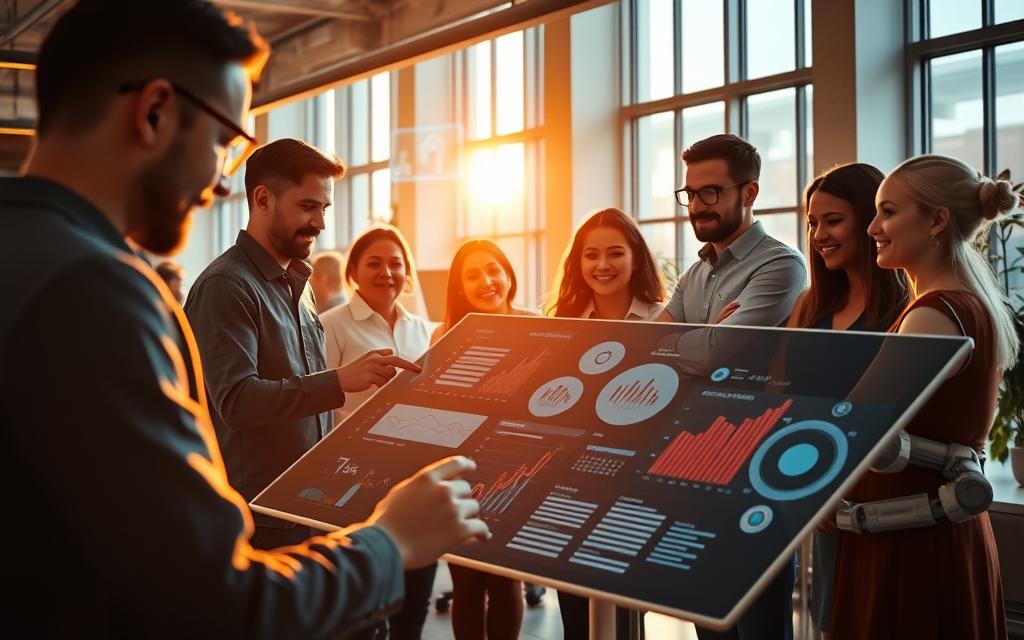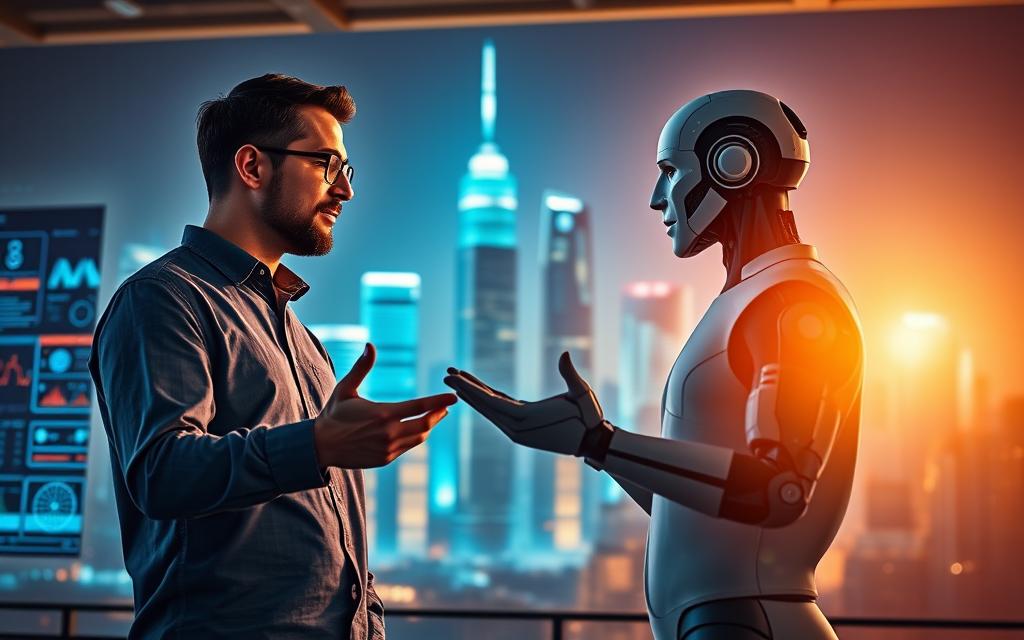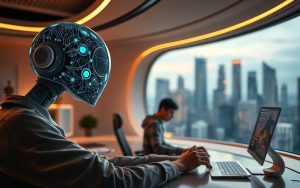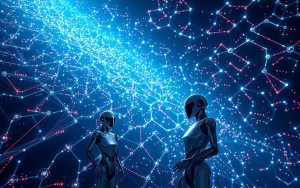Table of Contents
Technology is reshaping industries, but the real game-changer lies in blending human creativity with artificial intelligence. This dynamic duo unlocks new levels of efficiency and innovation.
Shervin Khodabandeh’s TED Talk highlights how collaboration between humans and machines creates unmatched value. Neither can fully replace the other—instead, they complement strengths.
From healthcare to finance, organizations are embracing this synergy. The result? Faster decision-making, reduced errors, and groundbreaking solutions. Ethical implementation remains crucial for long-term success.
Introduction: The Power of Human-AI Collaboration
Forward-thinking companies now see AI as a co-pilot rather than a replacement. This shift reflects a broader trend: blending human expertise with technology drives measurable results.
Fortune 500 firms accelerated AI adoption by 270% since 2019. The table below highlights key growth areas:
| Year | Companies Using AI | Primary Use Cases |
|---|---|---|
| 2019 | 37% | Data analysis, chatbots |
| 2023 | 72% | Decision support, automation |
Leaders like IBM and Salesforce design teams where humans oversee AI outputs. *Augmentation*—not replacement—fuels productivity. Shervin Khodabandeh’s TED Talk emphasizes mutual learning frameworks.
Three pillars ensure impact:
- Trust-building: Transparent AI workflows.
- Skill development: Upskilling for hybrid roles.
- Ethical governance: Bias mitigation protocols.
This approach turns potential into profit. People make good decisions; machines make good business scalable.
Complementary Strengths: Why People and AI Make Good Business Partners
Modern enterprises thrive when combining cognitive flexibility with computational power. This partnership maximizes efficiency while preserving the irreplaceable value of human insight.

AI’s Data-Driven Capabilities
Machines process 10,000x more data points than humans. In one hour, AI analyzes 2.5 million documents—a task requiring 5,000 human hours. Pharmaceutical firms use this for faster drug discovery.
Human Creativity and Ingenuity
Adidas designers partnered with Midjourney AI to reimagine sneaker concepts. The result? A 40% faster design cycle with bold, market-disrupting styles.
Synergy in Decision-Making
MIT research reveals teams blending AI insights with human judgment make 22% better decisions. Amazon’s inventory system exemplifies this, merging predictive analytics with managerial oversight.
| Metric | AI Alone | Human + AI |
|---|---|---|
| Data Processed | 10M points/hour | 10M points + context |
| Innovation Speed | Limited by algorithms | 2x faster (Adidas case) |
| Decision Accuracy | 88% (MIT) | 93% (MIT) |
This synergy unlocks opportunities across industries. As contact centers demonstrate, AI enhances real-time problem-solving while agents provide empathy.
Real-World Applications of Human-AI Partnerships
From hotels to space exploration, joint efforts yield groundbreaking outcomes. Organizations across sectors report measurable gains by merging human intuition with technology. Below are transformative examples reshaping the world.
Enhancing Customer Experiences
Hilton Hotels deployed “Connie,” an AI concierge supporting staff in 12 languages. Guests receive instant answers, while employees focus on personalized service. CRM systems with AI boost resolution times by 35%.
Optimizing Operational Efficiency
FedEx’s route optimization AI saves 4 million gallons of fuel yearly. Algorithms analyze traffic patterns, weather, and delivery windows. Human dispatchers fine-tune routes for last-mile exceptions.
- John Deere: AI-powered tractors increase crop yields by 15% through real-time soil analysis.
- Moderna: Accelerated COVID vaccine development using AI sequence modeling, cutting research time by half.
Driving Innovation in Industries
NASA’s Mars rover team collaborates with machine learning systems. AI processes terrain data, while scientists interpret findings. This partnership fuels discoveries beyond Earth.
“Machine learning talks to our engineers—it’s a dialogue, not a directive.”
Overcoming Challenges in Human-AI Collaboration
While powerful, integrating AI into business operations presents three critical challenges organizations must solve. Skills shortages, ethical risks, and trust gaps can hinder impact if unaddressed. Proactive strategies turn these hurdles into advantages.

Bridging the Skills Gap
PwC’s 2023 survey reveals 67% of workers need AI upskilling. Leading companies like IBM invest heavily—$2 billion for reskilling programs. Their hybrid roles combine coding literacy with human judgment.
Ensuring Ethical AI Use
The EU AI Act mandates human oversight for high-risk applications. Microsoft’s Responsible AI Standard sets benchmarks, including bias audits. Healthcare diagnostic tools now require physician validation, blending expert insight with algorithmic precision.
Building Trust in AI Systems
Boeing trains pilots on AI-assisted flight controls using simulators. Transparency in decision-making fosters confidence. As one engineer notes: “Trust grows when humans understand how machines think.”
- IBM: Reskilling 30,000 employees for AI-augmented roles by 2025.
- EU Regulations: Require human checks for AI in hiring or healthcare.
- Boeing: 200+ hours of AI-coordination training for cockpit crews.
The Future of Human-AI Partnerships
The next decade will redefine how humans and intelligent systems co-create value. As cognitive collaboration becomes mainstream, industries will unlock unprecedented opportunities.

Emerging Opportunities
Creative fields lead the transformation. Advertising agencies now pair art directors with tools like DALL-E, producing campaigns 60% faster. Boston Dynamics showcases another frontier—human-robot teams safely handling hazardous materials.
McKinsey projects 45% of workforce roles will transform by 2030. Three key shifts are coming:
- Augmented creativity: AI handles repetitive tasks while humans focus on big-picture strategy
- Real-time decision support: Systems provide instant data analysis during critical meetings
- Ethical oversight: 78% of Fortune 500 companies plan AI ethics boards by 2025
Redefining Workplace Roles
Shervin Khodabandeh predicts “cognitive collaboration” as the next productivity frontier. His research at BCG reveals hybrid teams outperform others by 3:1 margins.
The workplace of tomorrow blends human strengths with machine efficiency:
“The magic happens when we stop seeing AI as tools and start treating them as teammates.”
Expert Insights from Shervin Khodabandeh
The thought leader’s “Three Pillars of Sustainable AI Integration” framework guides enterprises:
- Continuous learning: Monthly skills updates for all employees
- Reciprocal feedback: Humans train AI, AI trains humans
- Transparent metrics: Clear KPIs for human-AI collaboration
As Khodabandeh notes in recent news interviews, this approach prepares organizations for a world where artificial and human intelligence coexist seamlessly.
Conclusion: Embracing the Collaborative Future
Blending human expertise with machine precision unlocks transformative potential. Companies report 30-50% efficiency gains when teams and tech work as partners.
Success hinges on continuous learning. Adaptive systems thrive when humans refine AI outputs. Shervin Khodabandeh champions “symbiotic innovation”—a balance of creativity and automation.
For lasting impact, start with three steps:
- Train staff to interpret AI insights
- Design workflows for mutual feedback
- Audit algorithms for ethical gaps
Stay ahead with TED Talk’s newsletter on collaboration trends. The best opportunities await those who embrace this evolution.
Subscribe now for cutting-edge insights.
FAQ
How does AI enhance human capabilities in business?
AI excels at processing vast amounts of data quickly, identifying patterns, and automating repetitive tasks. This allows professionals to focus on creativity, strategy, and complex problem-solving.
What industries benefit most from human-AI collaboration?
Sectors like healthcare, finance, retail, and manufacturing see significant impact. AI optimizes operations while human expertise drives innovation and customer engagement.
Can AI replace human jobs in the workplace?
AI augments rather than replaces roles. It handles data-heavy tasks, freeing employees for higher-value work that requires emotional intelligence and critical thinking.
What challenges do companies face when implementing AI solutions?
Key hurdles include upskilling teams, ensuring ethical AI use, and maintaining transparency. Trust-building between staff and technology is crucial for success.
How does Shervin Khodabandeh view the future of human-AI partnerships?
The expert emphasizes collaborative intelligence, where each complements the other’s strengths. He predicts transformative opportunities across global markets through this synergy.
What role does creativity play in human-AI collaboration?
Humans bring innovative thinking that AI cannot replicate. Creative problem-solving and emotional intelligence remain uniquely human advantages in partnerships.
How can businesses prepare for effective human-AI teamwork?
Companies should invest in training, foster a culture of continuous learning, and clearly define how technology supports rather than competes with human talent.









